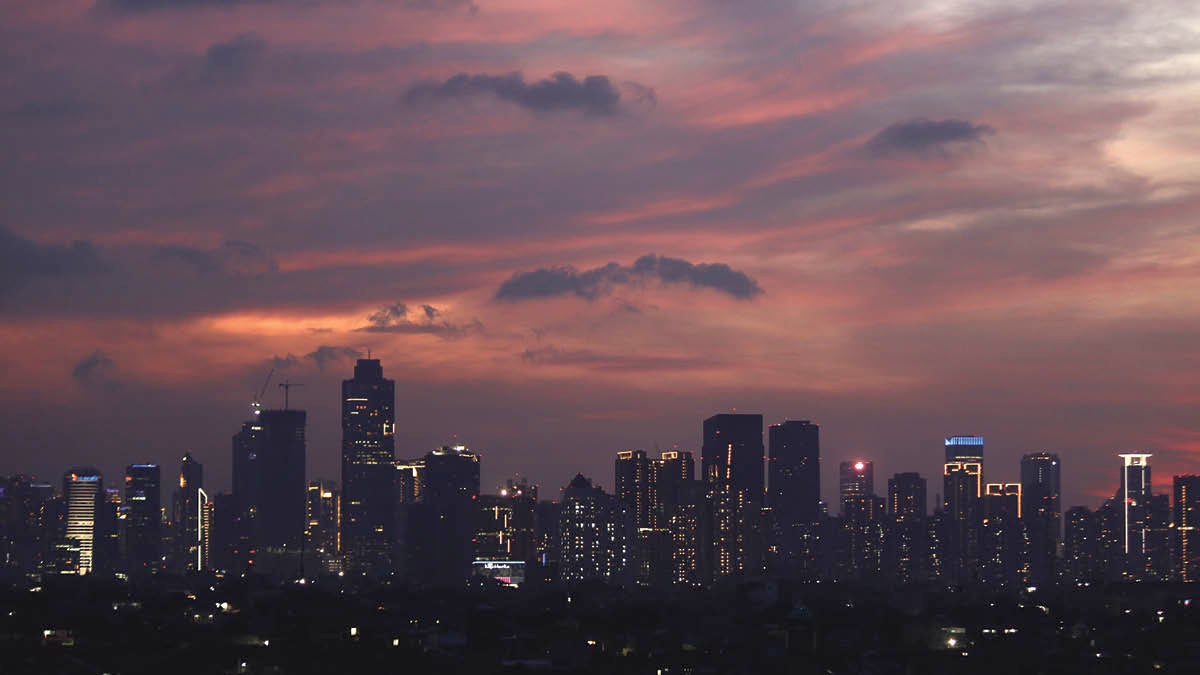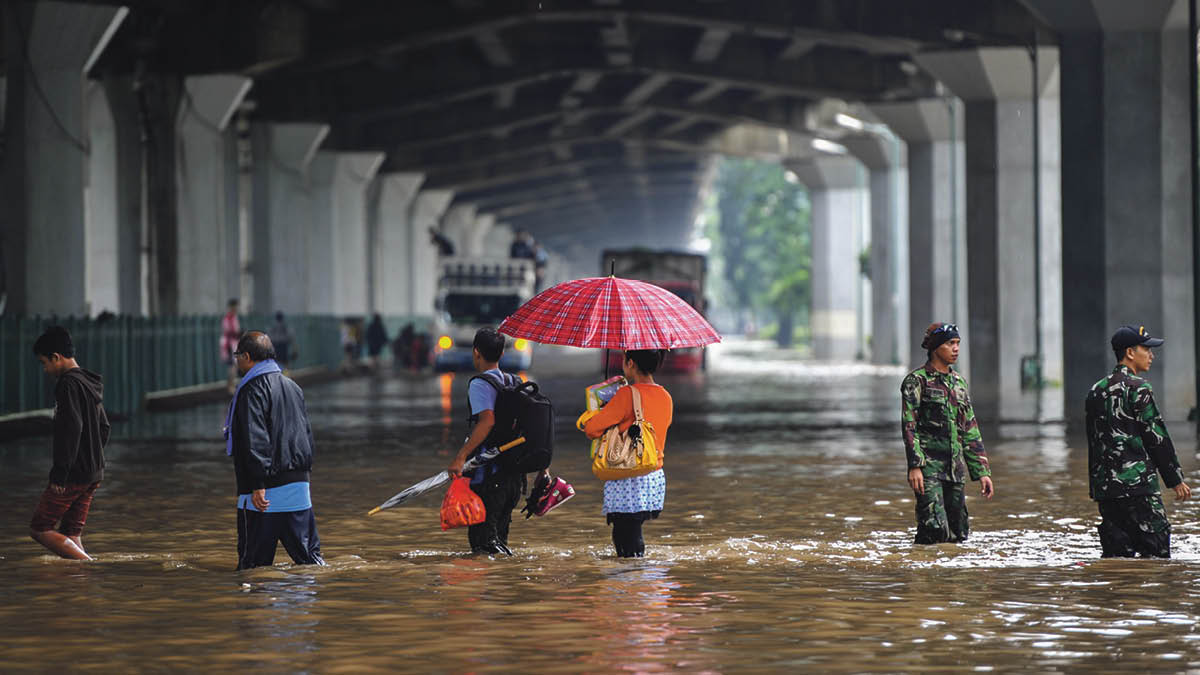
New generations of smart and sustainable cities could provide answers to the urban problems created by climate change, according to international architects, tech giants and leading politicians. But Indonesia’s plan to relocate its capital some 800 miles from Jakarta, to a new purpose-built capital on the island of Borneo, will provide an exacting test for such innovation.
As sea levels rise, Jakarta is sinking. The city is subsiding up to 20 centimetres annually due to over-extraction of groundwater from the swamp-like terrain beneath. Located on the circum-Pacific seismic belt, a zone along the rim of the Pacific Ocean known as the Ring of Fire for its frequent earthquakes and tsunamis, 40 per cent of the city is now below sea level.
Jakarta, home to ten million and choked by gridlock and seasonal smog, has been hit by increasingly frequent flash floods, which killed 66 people in one week in January.
President Joko Widodo has called for a brand-new capital to relieve pressure, with a $34-billion new city master plan announced in August 2019 for the forested province of East Kalimantan.
The new capital, advertised by Widodo as the “next Silicon Valley”, is viewed by Indonesians as both a much-needed solution to Jakarta’s ills and a precipitous dream, which might never materialise. As the country struggles to contain one of the deadliest outbreaks of COVID-19 in Asia, plans to break ground this year have been pushed back to 2023, shortly before the end of Widodo’s presidential term.
“Indonesia has this once in a century chance to take the lessons from our proud history and add innovations from the greatest cities in the world to develop a city with harmony, diversity and inclusiveness for all,” says Rudy Soeprihadi Prawiradinata, deputy for regional development at Indonesia’s Planning Ministry.
But a successful send-off for the man Indonesians call Jokowi will require the city to quickly attract residents – beyond the country’s politicians who will be forced to relocate to the new administrative zone – and drastically improve quality of life.
Cities’ development driven by transport
“The biggest urban design challenge is the lack of an existing population and starting a new city from the ground up in a greenfield location,” says Scott Dunn from multinational urban design firm AECOM, chosen in February to masterplan the capital. “Even with Asia’s rapid urbanisation, it takes time for cities to develop, mature and become desired destinations.”
Widodo has assembled an overseeing committee, intended to fast track foreign investment in the city and guide its development from scratch. Alongside AECOM, the committee includes Masayoshi Son, chief executive of Japanese holding company SoftBank, Sheikh Mohammed bin Zayed Al Nahyan, Crown Prince of Abu Dhabi, former British Prime Minister Tony Blair, and international consulting firms McKinsey & Company and Nikken Sekkei.
AECOM has learnt from its work in Riyadh, Saudi Arabia’s fast-growing capital, and Shenzhen, the nearest city in mainland China to Hong Kong. In Shenzhen, for example, rapid growth is being driven by the Guangzhou-Shenzhen-Hong Kong Express Rail Link. Likewise in Riyadh, AECOM have clustered development around transport hubs to create a “mega-metropolis”, expected to double in size in a decade, while sustainably improving liveability and mobility.
The goal is to make smart and sustainable cities that can adapt to unpredictable population growth and shocks like a pandemic: “A policy of transit-oriented development, which maximises the housing, employment and entertainment options within walking distance of public transit, is a good way to achieve that,” says Dunn.

Smart, sustainable urban development
Indonesia’s new capital will inevitably bring comparisons to purpose-built landmarks of past centuries, like Washington DC or Brasilia. “Some of the best elements of purpose-built capital cities will be incorporated as we learn from other cities: spacious parks, ease of movement, mixed-use community zones, inspiring public buildings and views,” says Prawiradinata.
But sustainable urban development today must be planned for its residents, rather than its iconography, explains Ed Baker, director of architecture practice Broadway Malyan’s Singapore studio. “The planning of the great purpose-built capital cities of the world was often a top-down process and underpinned by a desire for grand civic gestures and monumental architecture,” says Baker. “But by embracing a people-first ethos from the outset, Indonesia can create something that is much more meaningful and reflective of modern lifestyles, environmentally responsive and resilient to the challenges of climate change.”
AECOM proposes a “digital twin” city to provide real-time information on residents’ preferences as the city grows. “This can help with understanding population growth demands and the right balance of required land use, mobility networks, blue and green open spaces,” says Dunn.
Smart city tech developments have typically focused on infrastructure where the new capital can outperform Central Jakarta. Prawiradinata says intelligent systems can improve traffic grids, public transport, energy efficiency, and water and environmental sustainability.
SoftBank has offered to invest up to $40 billion in the new capital and chief executive Son has declared his interest in supporting the adoption of latest technology in smart and sustainable cities, notably artificial intelligence, and opening the door to the tech conglomerate’s developments in the internet of things and big data.
Smart cities’ sustainability on trial
Geographically near the heart of the country of more than 270 million people, it is hoped the new capital will develop the sparsely populated island of Borneo and balance the archipelago nation, where more than 60 per cent of economic activity is currently in Java.
The Indonesian government has promised to ringfence natural reserves on Borneo, known as home to the critically endangered orangutan, but already deforested for oil refineries and palm oil plantations. Prawiradinata says 75 per cent of the city would be retained as natural green space, which would mark a boost for biodiversity from the roughly 50 per cent currently forested: ”We will rebuild the forest, as we design.”
Leonard Simanjuntak, country director for Greenpeace Indonesia, says the city would create new crises as it mitigates Jakarta’s. He fears the city’s development plan would, over years, be compromised as it connects with nearby Balikpapan, centre of the local oil industry.
“While the new capital seems to be designed as a techno, smart and environmentally friendly city, it has inherent risks of uncontrollable urban sprawling,” says Simanjuntak. “And when this happened, a large chunk of forest areas would already be deforested, biodiversity sacrificed and the remaining wildlife would be under tremendous threat.”
Still, questions remain, among Indonesians who have been promised a more liveable capital since 1957 when a move was discussed by Indonesia’s first president Sukarno, if the city will ever be built.
If economic recovery from COVID-19 takes a few years, there will be vanishingly little time for progress to be made before the 2024 elections, says Bill Sullivan, senior foreign counsel at Jakarta-based law firm Christian Teo & Partners, who advises investors in Indonesia.
“In a better fiscal environment, it makes sense, because one of Widodo’s basic ideas is that infrastructure development is key to solving Indonesia’s endemic problem of unemployment,” says Sullivan.
“It’s possible that if nothing happens before 2024, it might still get some traction, but there will definitely be a risk that it’ll just cease to be an urgent priority for the next president.”
From a climate perspective alone, Simanjuntak of Greenpeace believes quietly scrapping the plans would actually be for the best. “Indonesia doesn’t need to build another Naypyidaw,” he says, referring to Myanmar’s purpose-built capital, unveiled 15 years ago and still largely deserted. “Even if it’s a smart and sustainable version of it.”

New generations of smart and sustainable cities could provide answers to the urban problems created by climate change, according to international architects, tech giants and leading politicians. But Indonesia's plan to relocate its capital some 800 miles from Jakarta, to a new purpose-built capital on the island of Borneo, will provide an exacting test for such innovation.
As sea levels rise, Jakarta is sinking. The city is subsiding up to 20 centimetres annually due to over-extraction of groundwater from the swamp-like terrain beneath. Located on the circum-Pacific seismic belt, a zone along the rim of the Pacific Ocean known as the Ring of Fire for its frequent earthquakes and tsunamis, 40 per cent of the city is now below sea level.
Jakarta, home to ten million and choked by gridlock and seasonal smog, has been hit by increasingly frequent flash floods, which killed 66 people in one week in January.





